Thanks to my patrons for supporting this article!
There are a tremendous number of factors that designers can tweak when creating a strategy game to shape gameplay. Ranging from broad concepts like: fog of war, unit acceleration, physics-based weapon firing, or gross economic models to more precise and minute ones like unit weapon reload type, unit aim time, unit animation backswing, or how long a harvester takes to gather a resource and how many resources it makes in a trip.
Games as different as AirMech and Supreme commander show us a large and diverse number of complex design permutations in many areas. One that’s consistently fascinated me is the decisions designers make around the permanence of a player’s investments.
What is the importance of ‘permanence’ in RTS games, what types of thing in the genre are typically ‘permanent’ investments? And what can and does permanence add to competitive strategy games? That’s what I want to look at. Thanks for coming along for the ride.
Economics Across Time: The Durability of your Investment
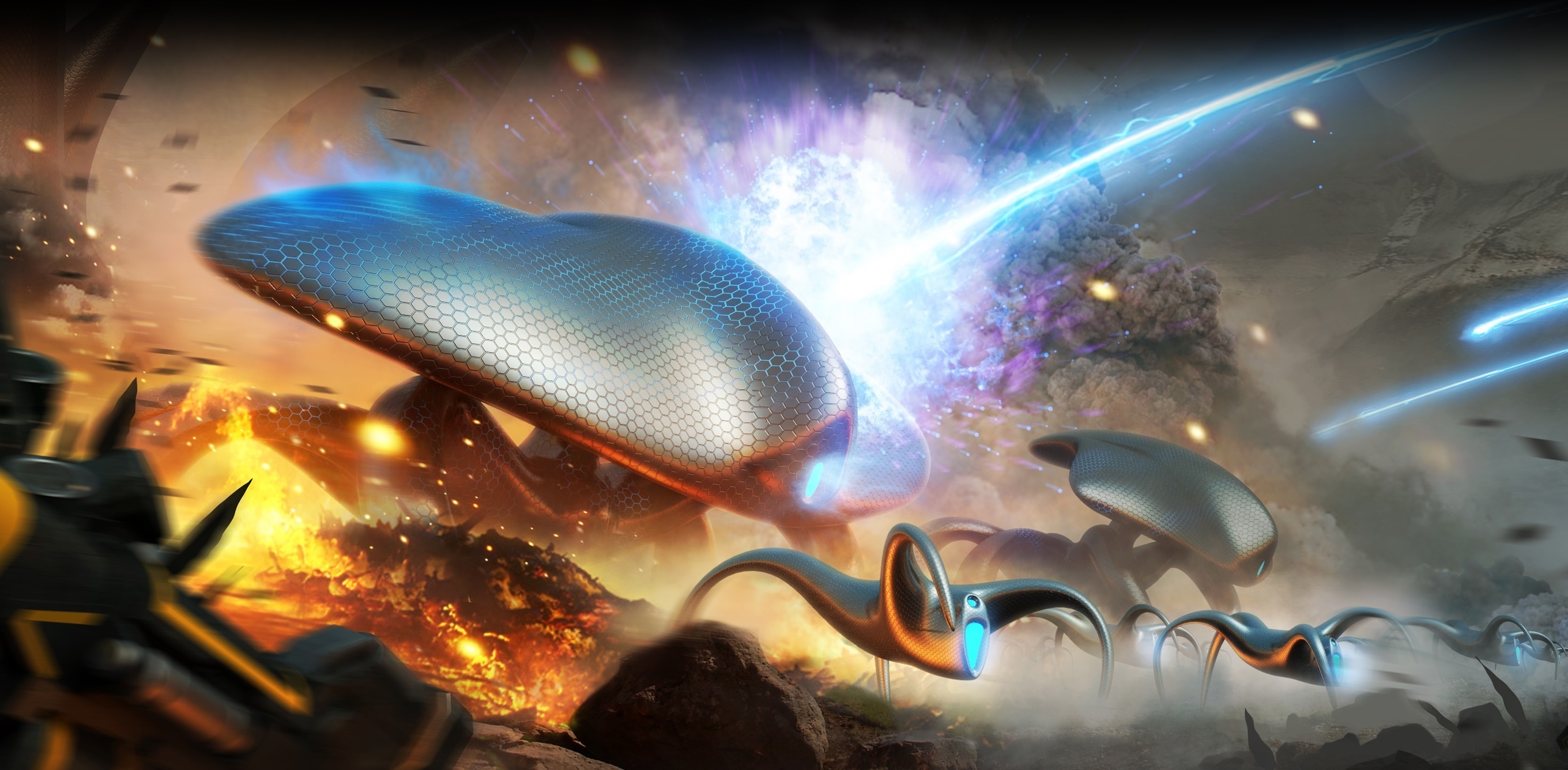
Ok, so what do I mean when I say “permanence of investments?” The term may sound a little overwrought, I suppose. But I’m trying to be precise here, so bear with me. In real-time strategy games, the player’s ability to act on the game comes at the cost of resources, which are accrued in various ways depending on which particular RTS you’re looking at (SCVs mining minerals, Harvesters gathering Tiberium, Metal Extractors gathering metal in Supreme Commander, etc.). In all cases, the assumption is that, without enemy interference, the player will continually increase the rate at which they generate resources as a round progresses, which will in turn allow them to exert progressively greater influence on the game via units, buildings, upgrades, and so on.
One of the core ideas in real-time strategy games is getting the best possible return on your investments; Winning often involves spending as few resources as you can to destroy as much of your opponent’s investments (and therefore ability to act on the game) as possible. The more efficiently you can use the resources you’ve invested, the more resources you have available to spend on further investments (units, buildings, upgrades, and whatever else the game allows) relative to your opponent.
You can actually, almost physically, feel this concept in action in a Zerg mirror match in StarCraft 2. Due to the design of Zerg production and units, being forced to re-invest in Drones has a cascading effect on a player’s production:
- You’re spending the time-limited resource of Larvae on re-puchasing units, which means you’re falling behind in unit production.
- You’re losing out on mining time, which means you’re falling behind in terms of actual income.
- And you’re incurring the additional costs of spending additional resources on Drones, which means you’re falling behind on other investments.
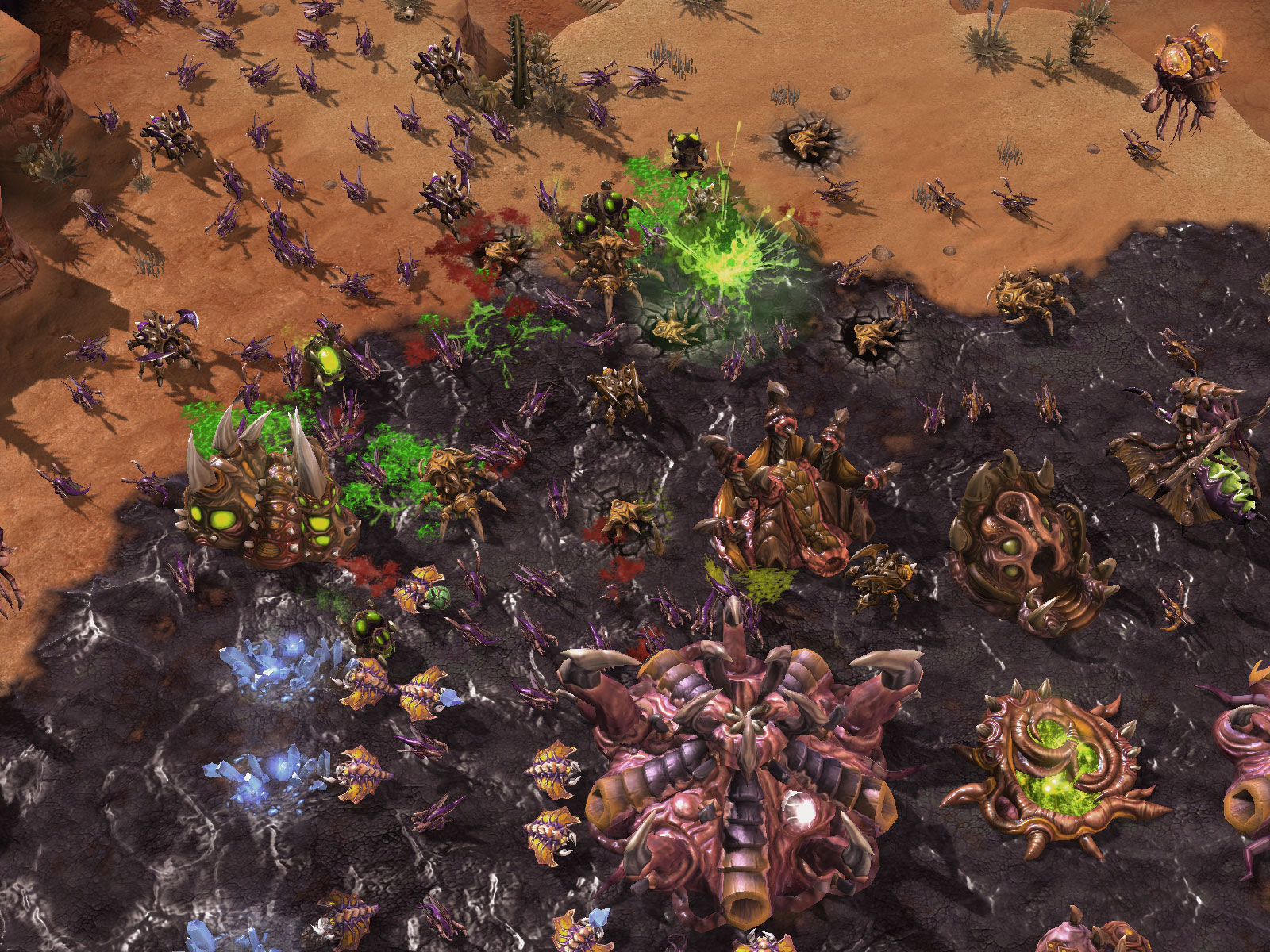
Falling behind in a Zerg mirror in StarCraft 2 demonstrates the concept of the ‘slippery slope’ or ‘snowballing’ in action.
“Durability” is the term I’ll use to describe the primary metrics that determine how difficult an investment is to remove from the game. That term covers concepts like unit or structure health, armor, accessibility, and recursion.
The durability of each unit is an important part of game balance: for instance, like in RPGs, RTS spell-casters can typically have a huge impact on the game state (e.g. killing a lot of enemy units, or setting up situations where a player is able to kill a lot of enemy units) but are usually expensive and easily killed, making them more difficult to use.
The duration of an investment (durability over time), though, is how long you are able to continue to benefit from a particular investment. A fragile unit like a Marine from SC2, or a rifle squad from a Command and Conquer game, is unlikely to have a substantially long duration. And the frequency of replacement is typically factored into the unit’s relative power and cost. Something like a Protoss Colossus in SC2, or a German Panther tank in Company of Heroes, is much more durable, and the cost of replacement is much higher and more restrictive.
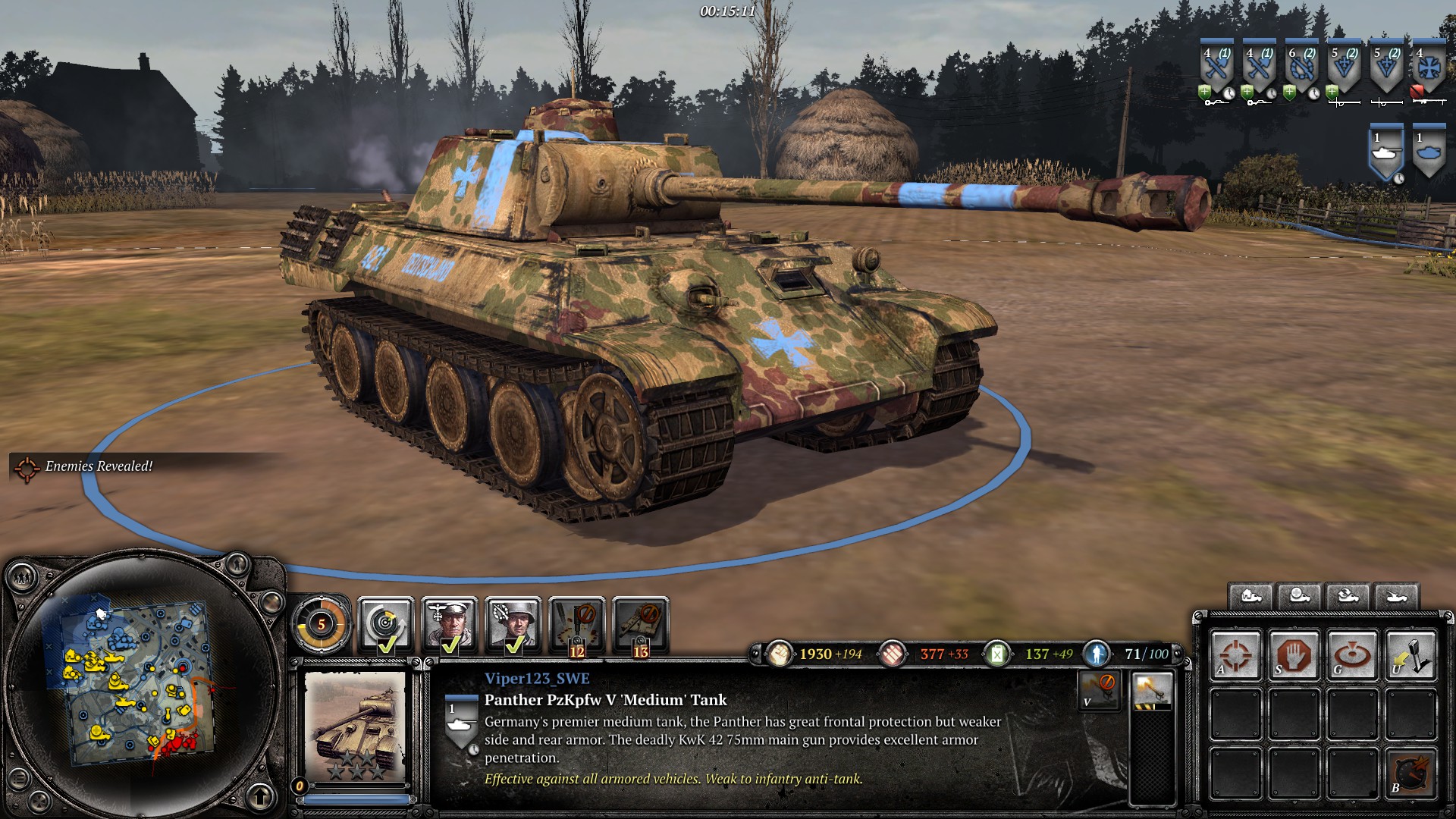
Speaking of that Panther… It’s not permanent: it can be destroyed. But, it has an interesting type of pseudo-permanence. First off, the tank can be de-crewed, and re-crewed by other infantry squads. So, if you’re lucky or skilled enough to de-crew an enemy tank, you can re-crew it with your units, drive it back to your base, and ready it to use against your opponent.
But, even destroyed or de-crewed, that tank remains on the battlefield, ready to serve as cover for infantry squads. That cover can be destroyed as well, but decisions on how to react to the husk of a tank provide an interesting dynamic for the game from the moment a tank hits the field.
For an example of true unit permanence, let’s take a look at Elites in Dawn of War 3 before moving on. If you don’t know, Elites in DoW3 are selected by players before a match. Once within the game, players accrue a special resource called Elite Points. Each elite requires an initial investment of Elite Points to summon.
These investments once made cannot ever be permanently removed from the match. They do have a lengthy cooldown if killed before being able to be re-summoned. But once you drop down the initial Elite Point cost for them, they’re yours for the rest of the game. This was intended to be an equalizer for the player: you always have something you can rely on, even if your army might be radically depleted. Unfortunately, since there’s no noticeable penalty for fielding powerful Elites, the player/team with the economic or army advantage is just going to have yet another lever to use against their opponent.
In the case of Dawn of War 3, this permanence of Elite units, in terms of cost, not invulnerability, was intended to act as a rubber-band or bulwark against ‘slippery slope’ escalations. And it doesn’t succeed as well as it could in my opinion.
The Slippery Slope

Dawn of War 3 seeks to soften the ‘slippery slope’ via Elite units, combat phases, and changes to resourcing mechanics that have different types of player disadvantage
I’m sure you’re aware of the term ‘slippery slope’ or ‘snowballing’ as they apply to RTS games, but just in case: these both refer to different sides of the phenomenon. The slippery slope is the experience of small setbacks in a competitive game compiling over time, making it more likely for a player who experiences a setback to run into more. Or like a snowball rolling down a hill, how a player who has gained an advantage is more likely to continue to pick up advantages.
As in the concept of the Zerg vs Zerg match described above, the loss of resources (time and income) from losing Drones compounds forward into the match. Lowering income curves and army growth rates to levels that, played at a certain level or skill, can become almost insurmountable. Achieving parity to one’s opponent or to initiate an attack of sufficient impact to counter their increased advantage often feels out of reach.
In Legacy of the Void, we saw several economics changes to SC2’s economic model intended to reduce the amount of time the player spends vulnerable to coin-flip setbacks in the early stages of the game. Other changes incentivized and enabled players to expand quickly and continually, ramping up to a solid mid-game economy earlier than in previous versions of the game. Notably, the player now starts off with more harvesters, and the speed at which minerals are depleted at each base location both enables and pushes the player towards a quicker ramp-up of their economy and requires more constant expansion around the map.
All right, we’ve blathered on long enough. Let’s start tying this together into something that resembles a coherent narrative.
Tying Things Together
So, we have started with the idea that real-time strategy games tie the ability of the player to act on the game to income. Adding to this is the idea that efficiency with one’s resources allows them to continue to progress in the game, and that durability or duration are a component of efficiency.
Now, we’re going to put this in the context of the slippery slope, and how disadvantages can pile up. Afterwards, we’ll look to see how permanence can impact player disadvantages.
Disadvantages
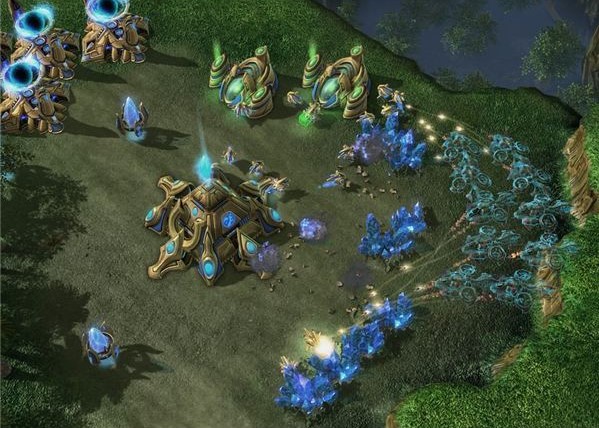
While there are a large number of ways that a player or team can be put at a disadvantage relative to their rival, I want to focus only on 3 of them:
- Time-based disadvantages where the player must wait for something to happen, and loses out on their ability to interact with aspects of the game for some time, opening up their opponent to execute strategy with less opposition. Examples of time-based disadvantage are
- Retreating a squad in Company of Heroes. The time the squad takes running back to the nearest rally point is time they aren’t spending controlling territory. Typically, a retreat also means time must be spent to reinforce the unit(s) that make up the squad, further freeing up the enemy to take control of territory unopposed.
- Having an army out-of-position in Supreme Commander. Due to unit speed relative to map size, mobilizing an army across a significant portion of the map can give one’s opponent the time to capture resource nodes, destroy infrastructure, or otherwise harm vulnerable investments.
- Losing enough Generators to lose power in a Command and Conquer game. This disables all structures, shutting down production and automated defenses.
- Expending a caster unit’s energy/mana, or cooldowns. The ability to impact the game in these extreme ways will return, but the player has to wait. In the meantime, their investment is a lame duck.
- Losing a Carryall in a Dune game. This forces the player to build a new one (if possible) and dramatically increases harvest time.
- Resource-based disadvantages where the player is put at an economic disadvantage relating to the types and quantity of tool they are able to bring to bear. Resource-based disadvantages can act as a force multiplier for other types of disadvantage. For instance:
- Losing a Spice Harvester in a Dune game, especially one that has already been loaded up with Spice.
- Losing harvesters in StarCraft. This reduces income, which as we’ve already discussed has a compounding effect on economy. There’s a lesser disadvantage to losing production structures, which limits the player’s ability to spend the resources they’ve acquired.
- Action-based disadvantages, which limit the player’s ability to continue to impact the game-state. Mostly, this consists of losing units or structures.
These types of disadvantages are often interrelated in complex ways that differ from game to game and even within a particular game (Drone loss for Zerg includes all 3 of them, for instance).
With both resource and action-based disadvantages, the player is directly and permanently losing their present and/or future ability to continue to act on the game. Time-based disadvantages are in a way the most forgiving, and least common, forms of disadvantage in real-time strategy games: the player is only temporarily losing their ability to interact with the game. From Elites in Dawn of War 3 to the titular hero units in AirMech, to Champions in League of Legends or Dota 2, there are plenty of games in which players have access to tools that can’t be taken from them permanently.
Invulnerability?

A prime example of permanence that is found in most RTS games are Tech Upgrades. In RTS games, while Upgrades are typically permanent, their utility is frequently tied directly to the unit, unit class, building, or feature that’s been upgraded.
For example: Experience, related to leveling or ranking up a unit, is a permanent Upgrade advantage tied specifically to the unit that earned it. While weapon and armor upgrades in most games apply to an entire set of units (such as Infantry or Air units).
Sometimes, vehicles or weapons are permanent or semi-permanent, and remain when the infantry units manning them are killed off (as in Company of Heroes 2).
Indeed, giving something increased durability or even “permanence” in a game doesn’t necessitate making it invulnerable. There are many ways designers can shape what permanence means for their players.
Time-Based Disadvantages (and What MOBAs get Wrong)
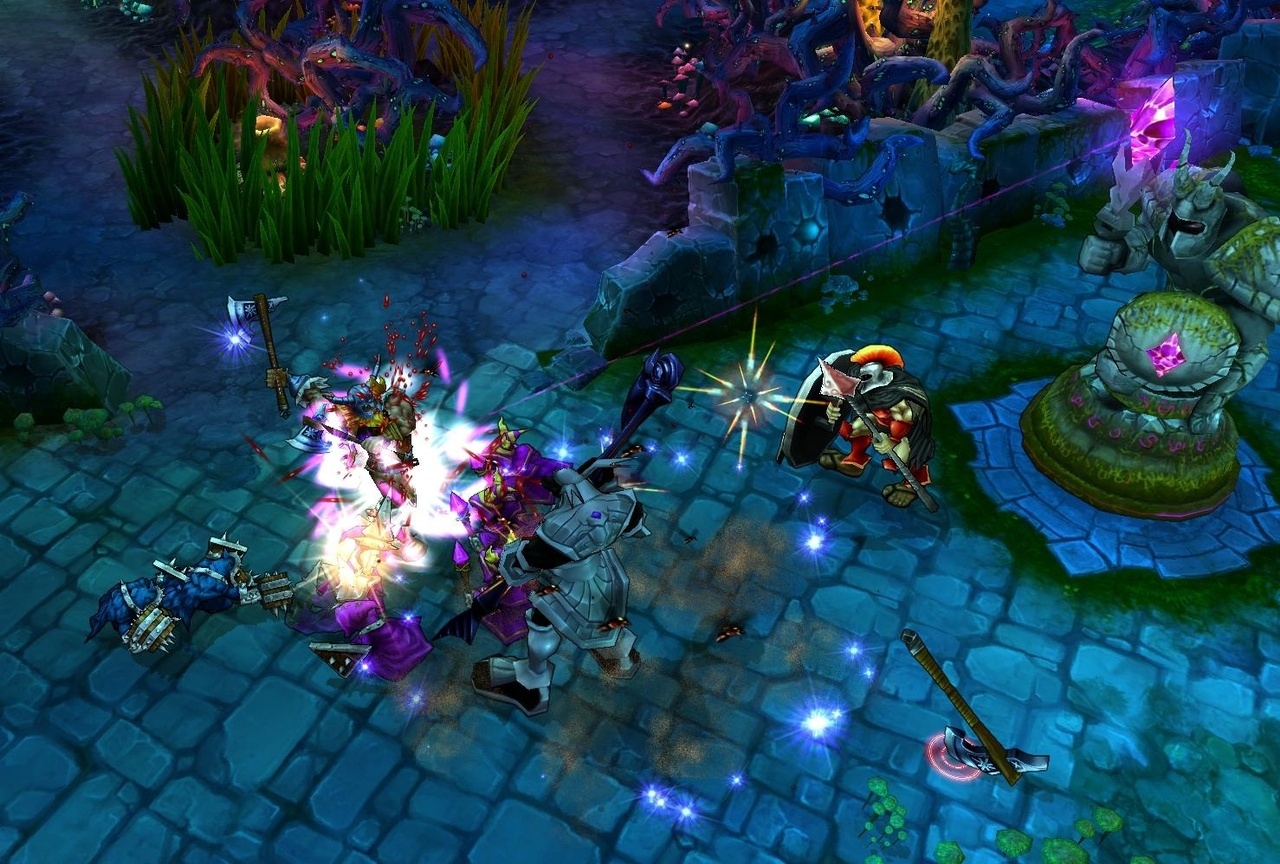
While it might be funny to groan and say something like “ugh what don’t MOBAs get wrong” that really doesn’t serve any practical purpose when talking about the design of strategy games. I’ve said before that MOBAs do actually have things to teach RTS developers and designers (but that many of those lessons are perhaps better taught by real-time tactics games like Myth, Wargame, or World in Conflict).
It’s instructive to a student of RTS design to look at specifically what it is about a MOBA that has appeal for competitive game design, and what it is that might introduce unnecessary complication, or detract from a game design.
Let’s start with what MOBAs do in the context of ‘permanence.’ Barring Dota 2, most MOBAs treat virtually every part of the player’s game experience as unable to be lost, only delivering the time-based disadvantage of the respawn timer when dead, or the time-based opportunity cost of running back to the ‘base’ to shop or refill their health and mana bar.
The problem with all of this is that, lacking any resource or investment that can be meaningfully removed from the enemy player or team, gameplay in MOBAs tends to devolve largely into a contest purely of momentum. The team with the most consistent momentum will gather the most XP, the most gold, the most skill points, and the best items, with each advantage compounding the effects of the others exponentially.
Obviously, this is an over-simplification: team composition and individual skill in combat encounters can tip the scales in favor of a team who has fallen behind in the ‘momentum’ game. But since XP and gold come from killing, and both XP and gold add directly in most cases to player and team power, there’s an inarguable correlation between the level and gold a team has earned and their performance in battle.
MOBAs are in many ways scaled down drastically from RTS games: each player is responsible for (with few exceptions) a single ‘game piece’ that is augmented by one resource that cannot be depleted (experience) and a handful of resources that can, if only temporarily (mana/energy/rage and gold). It is impossible to permanently remove a player from the game, so gameplay tends to resolve on a handful of fairly binary axes: being where the enemy isn’t, absolute rate of income, and putting a significant portion of the enemy team into their death timer state.
I’ve talked before about the benefits of having multiple avenues for players to operate on to succeed at a competitive game. I’ve talked about my desire for homeostasis in strategy games that is difficult to disrupt. And it is here where I feel MOBAs tend to fail. They put their eggs into too few baskets. They provide too few hooks onto which a victory can be hung. They suffer from the implementation of their version of permanence.
Resource-Based Disadvantages, and What RTS Can Do Better
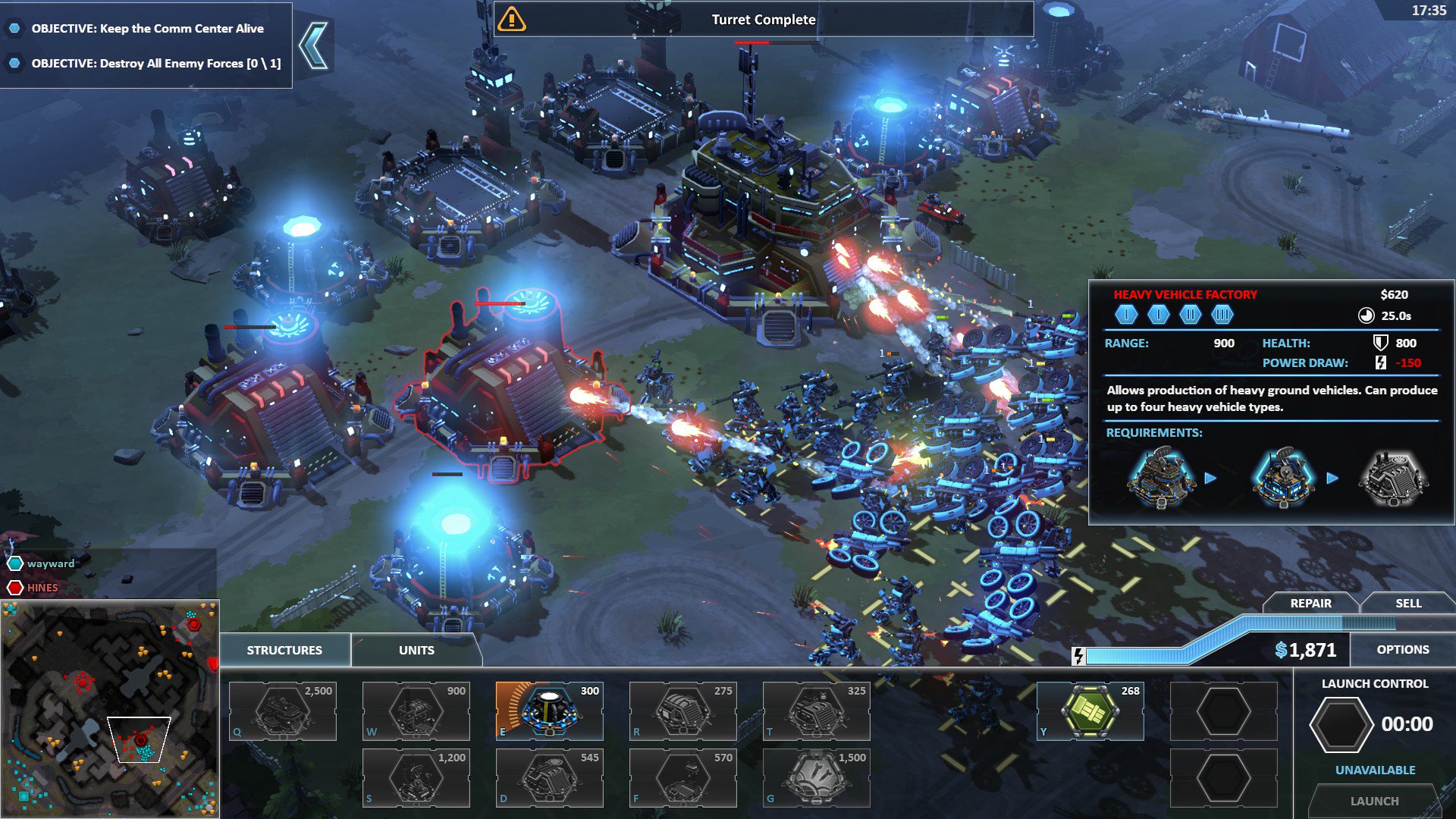
RTS, of course, tend to commit the opposite error (if you consider it an error, as I do): Everything you do, every advantage you accrue, is destructible. And worse, in my view, is that the various aspects of these games are so interrelated that most losses echo forward in time in an escalating way (that slippery slope in action).
I am a proponent of what I call ‘equilibrium‘ in strategy game design, where victory comes not from removing the ability of one’s opponent to interact with the game, but by consistently performing better at completing objectives. Time-based disadvantages, applied appropriately, are one way (I discussed the idea of ‘ammunition’ in a previous article) to help insure that players don’t end up feeling powerless or without recourse in a competitive strategy situation.
If MOBAs are about momentum, where all that matters is the rate of forward progress, RTS tend to be a balancing act. In both cases, being set back has compounding effects: MOBAs, because there are too few moving pieces, and RTS because there’s no limit to how far you can be set back.
In games like AirMech, Dawn of War 3, and World in Conflict, we see the possibility of a middle ground. Where there are always assets that are a short wait away from being usable again, but where economics still matters and skillful play can still net overwhelming advantages. All 3 games have a variety of elements and advantages that cannot transfer to another player and cannot be permanently removed from the player’s control, though AirMech and Dawn of War 3 mix it up a bit by mixing the permanent investment of Elites (or AirMech/experience) with investments that must be managed efficiently from a resource perspective.
Armies. I mean armies there. Armies are the ‘investments that must be managed efficiently from a resource perspective’ in case you were wondering.
Wrapping it Up
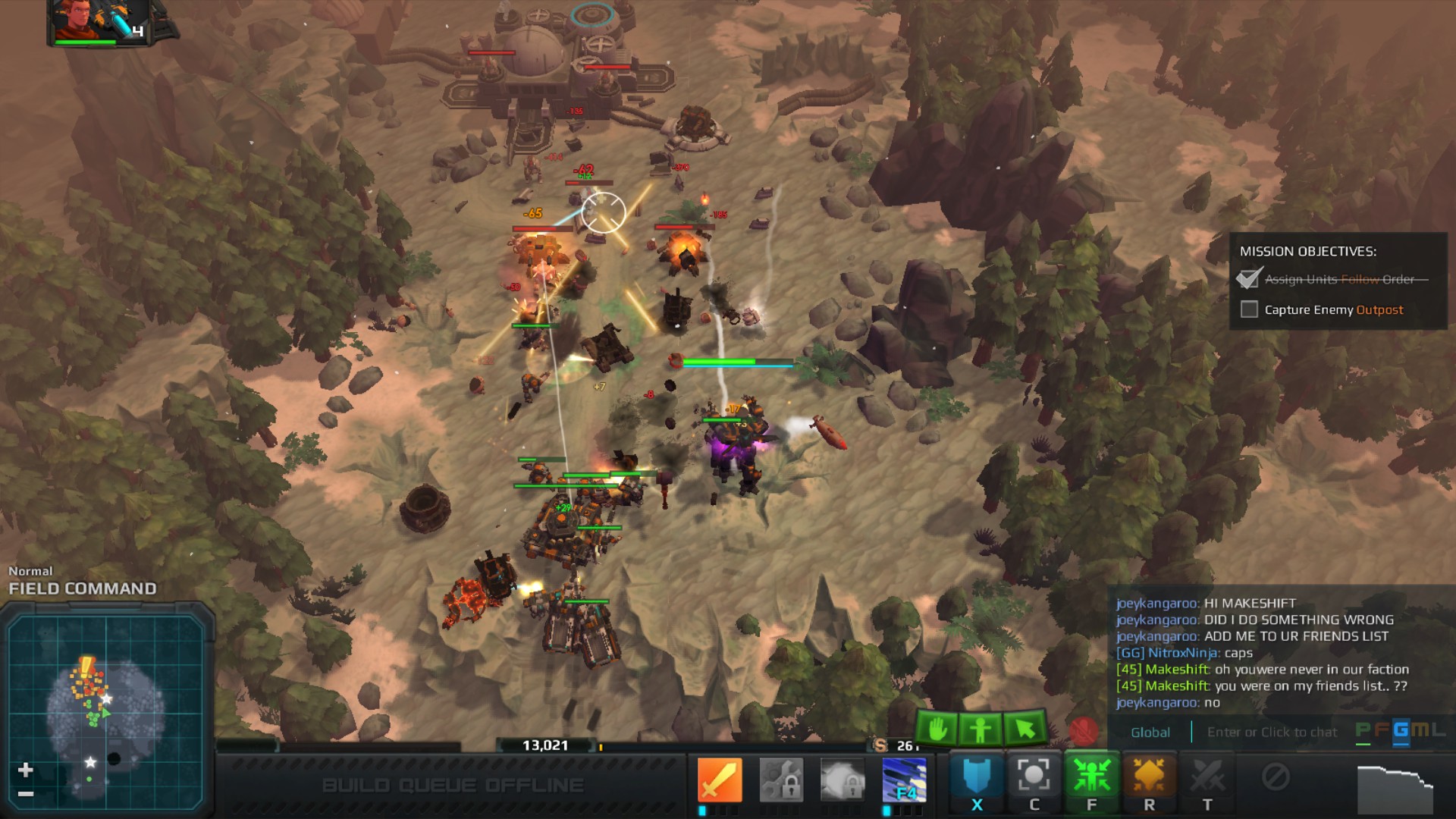
Successful RTS tend have designs that don’t put all of players’ eggs in one basket: Company of Heroes features semi-permanence with crewed weapons and rifles, temporary economic setbacks in the form of territory cutoff, a victory-point based win condition that can be achieved even with inferior forces. Supreme Commander spreads economy across the whole map and allows a player to ‘snipe’ the enemy ACU for a win, regardless of army strength.
Flipping that idea around, we can see that having assets that can’t be (permanently) removed from a player’s control can create a bit of breathing room, another category of threat to be handled, and can create a ‘tempo’ to gameplay. All-or-nothing scenarios create a tightrope that only the most hardcore find appealing, and being robbed of your ability to even act on the game isn’t an experience with broad appeal.

